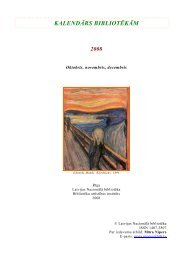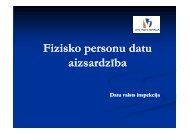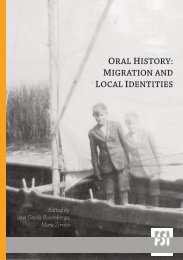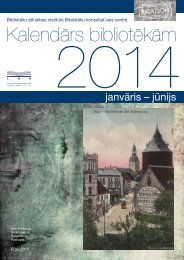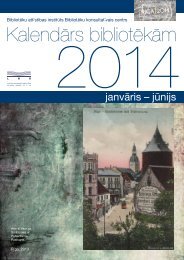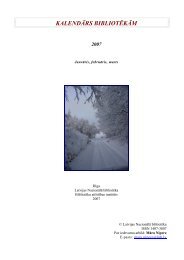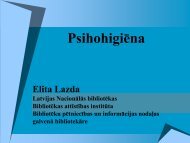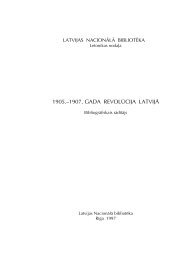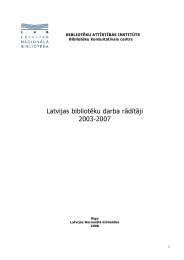representation of the countryside and agriculture as values - Academia
representation of the countryside and agriculture as values - Academia
representation of the countryside and agriculture as values - Academia
- No tags were found...
You also want an ePaper? Increase the reach of your titles
YUMPU automatically turns print PDFs into web optimized ePapers that Google loves.
LATVIJAS SOCIĀLĀ ATMIŅA UN IDENTITĀTEMANUSKRIPTISOCIAL MEMORY OF LATVIA AND IDENTITYWORKING PAPERSKlinta LočmeleREPRESENTATION OF THECOUNTRYSIDE ANDAGRICULTURE AS VALUESIN THE LATVIAN NATIONAL IDENTITY IN THE DAILY“LATVIJAS AVĪZE” (2004–2008)ISSN 1691-90172011. 4. LAIDIENS / VOLUME 4
Klinta LočmeleREPRESENTATION OF THE COUNTRYSIDE ANDAGRICULTURE AS VALUES IN THE LATVIAN NATIONALIDENTITYin <strong>the</strong> daily “Latvij<strong>as</strong> Avīze” (2004–2008)Paper h<strong>as</strong> been presented in <strong>the</strong> conference “Lithuanian euro‐integration, nationalidentity, <strong>and</strong> collective historical memory” (Vilnius, November 20–21, 2009) <strong>and</strong>published <strong>as</strong>: Ločmelė, Klinta. Kaimo ir žemės ūkio kaip latvių taunės tapatybėsvertybių vaizdavim<strong>as</strong> dienraštyje LATVIJAS AVĪZE (2004–2008). In: Gaižutytė‐Filipavičienė, Ž., Rubavičius, V. (eds). Nacionalinis tapatum<strong>as</strong> medijų kultūroje (NationalIdentity in <strong>the</strong> Media Culture). Vilnius: Lietuvos kultūros tyrimų instut<strong>as</strong>, 2011.P. 223–234. (ISBN 978‐609‐427‐062‐8)
LATVIJAS SOCIĀLĀ ATMIŅA UN IDENTITĀTEMANUSKRIPTI. 2011. 4. LAIDIENSSOCIAL MEMORY OF LATVIA AND IDENTITYWORKING PAPERS. 2011. VOLUME 4ISSN 1691-9017Laur<strong>as</strong> Āboliņ<strong>as</strong> un Mārtiņa Z<strong>and</strong>berga vāka dizainsCover design by Laura Āboliņa <strong>and</strong> Mārtiņš Z<strong>and</strong>bergsCountryside <strong>and</strong> <strong>agriculture</strong> historically have been seen <strong>as</strong> one <strong>of</strong> <strong>the</strong> strongest pillars <strong>of</strong>Latvian national identity. Since <strong>the</strong> first national awakening in <strong>the</strong> middle <strong>of</strong> 19thcentury in culture <strong>and</strong> ideology, Latvians have positioned <strong>the</strong>mselves <strong>as</strong> farmers,particularly during <strong>the</strong> first Republic <strong>of</strong> Latvia (1918–1940). Viewpoint about Latvians <strong>as</strong>ploughman nation revived again after <strong>the</strong> dissolution <strong>of</strong> USSR <strong>and</strong> retrieval <strong>of</strong> l<strong>and</strong>edproperty. Latvia experienced a rapid incre<strong>as</strong>e <strong>of</strong> <strong>the</strong> number <strong>of</strong> farms.Now Latvia is a part <strong>of</strong> Europe’s present‐day political, economic <strong>and</strong> cultural system <strong>of</strong><strong>values</strong>. Social, economic <strong>and</strong> political circumstances have determined changes in <strong>the</strong>prestige <strong>of</strong> <strong>the</strong> <strong>countryside</strong> <strong>and</strong> <strong>agriculture</strong>. Analysis <strong>of</strong> <strong>the</strong> newspaper “Latvij<strong>as</strong> Avīze”content shows that today <strong>the</strong> <strong>countryside</strong> <strong>and</strong> <strong>agriculture</strong> are at a crossroads when itcomes to <strong>the</strong>ir meaning, future <strong>and</strong> value. It means, that <strong>the</strong> b<strong>as</strong>ic elements <strong>of</strong> Latvianidentity, probably is starting to fall to pieces.Key words: national identity, <strong>countryside</strong>, <strong>agriculture</strong>, <strong>representation</strong>, <strong>values</strong>, “Latvij<strong>as</strong>Avīze”© Klinta Ločmele, 2011© Laura Āboliņa, Mārtiņš Zanbergs, vāka dizains, 20112
ContentDiscourse <strong>of</strong> <strong>agriculture</strong> 5Returning to p<strong>as</strong>t: initial hopes <strong>and</strong> collapse 6The newspaper “Latvij<strong>as</strong> Avīze” <strong>and</strong> methodology 8The main research results 10An <strong>agriculture</strong>: mission or business? 10Farmers <strong>and</strong> Latvians: common character 12Modernisation instead traditions 13The present roles <strong>of</strong> <strong>the</strong> <strong>countryside</strong> 14Conclusion 16Summary 18Bibliography 203
Paper is focused on analysis <strong>of</strong> <strong>the</strong> way in which <strong>the</strong>re is mediated<strong>representation</strong> <strong>of</strong> <strong>the</strong> <strong>values</strong> <strong>of</strong> <strong>the</strong> Latvian nation in terms <strong>of</strong> <strong>the</strong> <strong>countryside</strong> <strong>and</strong><strong>agriculture</strong>. Media <strong>representation</strong> <strong>of</strong> <strong>the</strong>se <strong>values</strong> provides evidence <strong>of</strong> shifts in nationalidentity.The <strong>countryside</strong> <strong>and</strong> <strong>agriculture</strong> have undeniably been <strong>of</strong> historical importancein <strong>the</strong> establishment <strong>and</strong> maintenance <strong>of</strong> <strong>the</strong> national identity <strong>of</strong> Latvians. Latvians havepositioned <strong>the</strong>mselves <strong>as</strong> farmers, <strong>and</strong> <strong>the</strong>y have seen <strong>the</strong> <strong>countryside</strong> <strong>as</strong> <strong>the</strong> main placewhere Latvianness, <strong>the</strong> stability <strong>of</strong> <strong>the</strong> nation <strong>and</strong> its traditions are preserved. Changesin <strong>the</strong> prestige <strong>of</strong> <strong>the</strong> <strong>countryside</strong> <strong>and</strong> <strong>agriculture</strong>, <strong>as</strong> well <strong>as</strong> in Latvia’s socioeconomic<strong>and</strong> political circumstances have also led to changes in <strong>the</strong> meaning, which is attachedto <strong>the</strong> <strong>countryside</strong> <strong>and</strong> <strong>agriculture</strong> in terms <strong>of</strong> <strong>the</strong> value system <strong>of</strong> <strong>the</strong> Latvian nationalidentity <strong>and</strong> its <strong>representation</strong> in <strong>the</strong> media. Here I specifically refer to <strong>the</strong>transformation <strong>of</strong> b<strong>as</strong>ic elements <strong>of</strong> national identity in <strong>the</strong> daily “Latvij<strong>as</strong> Avīze.” As <strong>the</strong>meanings have changed, national identity itself h<strong>as</strong> changed, <strong>as</strong> well.The aim <strong>of</strong> my research w<strong>as</strong> to look at <strong>the</strong> meaning, which “Latvij<strong>as</strong> Avīze”attached to <strong>the</strong> <strong>countryside</strong> <strong>and</strong> <strong>agriculture</strong> during <strong>the</strong> first five years after Latvia joined<strong>the</strong> European Union (2004–2008). I have looked at <strong>the</strong> issue <strong>of</strong> whe<strong>the</strong>r <strong>the</strong> way inwhich <strong>the</strong> paper presents <strong>the</strong> <strong>countryside</strong> <strong>and</strong> <strong>agriculture</strong> represents <strong>values</strong> related to<strong>the</strong> Latvian national identity or whe<strong>the</strong>r <strong>the</strong>y are gradually being eliminated from those<strong>values</strong>.4
Discourse <strong>of</strong> <strong>agriculture</strong>In <strong>the</strong> middle <strong>of</strong> <strong>the</strong> 19 th century a part <strong>of</strong> Latvian nation representatives strivedto dispose <strong>of</strong> <strong>the</strong> unification <strong>of</strong> concepts “Latvian” <strong>and</strong> “farmer” due to serfdom madepoverty. But simultaneously, c<strong>of</strong>ormable to <strong>the</strong> ideologs’ viewpoint <strong>of</strong> discussed period,farmers’ emancipation also w<strong>as</strong> Latvians’ emancipation, who formed <strong>the</strong> b<strong>as</strong>e forequality <strong>and</strong> wholesomeness <strong>of</strong> Latvian nation (Plakans, 1974, 1981).After <strong>the</strong> establishment <strong>of</strong> independent state in 1918, Latvia w<strong>as</strong> rustled by“farming wave”. About agrarian reform that w<strong>as</strong> conducted in <strong>the</strong> first Republic <strong>of</strong>Latvia historian Katrina Z. S. Schwartz (2006, 8, 43) h<strong>as</strong> written that it w<strong>as</strong> done with <strong>the</strong>purpose <strong>of</strong> creating a nation <strong>of</strong> farmers – conservative <strong>and</strong> ethnical homogeneous.O<strong>the</strong>r historians, for example, Arnolds Aizsilnieks (1968, 233–257) also point out thatcreating wide farmers’ stratum w<strong>as</strong> guarantee for social stability <strong>and</strong> safety <strong>of</strong> newRepublic <strong>of</strong> Latvia – allocated plots developed citizens who were loyal to authority <strong>of</strong>Republic <strong>of</strong> Latvia. 1The discourse <strong>of</strong> <strong>agriculture</strong> w<strong>as</strong> praised in art <strong>and</strong> monuments. It w<strong>as</strong>particularly <strong>the</strong> authoritarian regime <strong>of</strong> President Kārlis Ulmanis, which supportedfarmers <strong>as</strong> <strong>the</strong> source <strong>of</strong> Latvian culture. Ulmanis himself embodied <strong>the</strong> image <strong>of</strong> aproper Latvian farmer <strong>as</strong> something, which would be understood in terms <strong>of</strong> <strong>the</strong>mentality <strong>of</strong> Latvians (Butulis, 1999, 7, 19). Also during <strong>the</strong> same period, <strong>the</strong> Latvianphilosopher Pauls Jurevičs (1936, 235–239) published a book in which he declared that“<strong>the</strong> Latvian nation can only be saved by our holding on to <strong>the</strong> <strong>countryside</strong>.” K. Schwartz(2006, 8) summarizes that <strong>the</strong> nature <strong>of</strong> <strong>the</strong> nation w<strong>as</strong> entwined with <strong>the</strong> <strong>values</strong> <strong>of</strong>farmers <strong>and</strong> <strong>the</strong>ir work.During <strong>the</strong> Soviet era, single‐family farms were closed down, <strong>and</strong> collectivisationw<strong>as</strong> organised. The “poesy <strong>of</strong> <strong>agriculture</strong>” began to be established in Latvian culture,particularly in <strong>the</strong> literature <strong>of</strong> <strong>the</strong> late 1960s <strong>and</strong> early 1970s (Hausmanis, 2001). Theidea <strong>of</strong> <strong>the</strong> close link between Latvianness <strong>and</strong> farming survived <strong>the</strong> 50 years <strong>of</strong> Sovietrule <strong>and</strong> w<strong>as</strong> also placed into <strong>the</strong> cradle <strong>of</strong> <strong>the</strong> restored Republic <strong>of</strong> Latvia.1 More about agrarian reform see also Bērziņš, V. (ed.). (2003). 20. gadsimta Latvij<strong>as</strong> vēsture. (Vol. 2,pp. 380–395). Rīga: Latvij<strong>as</strong> vēstures institūta apgāds.5
Returning to p<strong>as</strong>t: initial hopes <strong>and</strong> collapseDuring <strong>the</strong> post‐Soviet Latvian renaissance, historians supported <strong>the</strong> idea that<strong>the</strong>re should be just one historical narrative – that <strong>of</strong> continuity between <strong>the</strong> p<strong>as</strong>t (<strong>the</strong>first republic) <strong>and</strong> <strong>the</strong> restored Latvian state (Jubulis, 2007). Cultural sociologistDagmāra Beitnere (2003, 8) emph<strong>as</strong>izes that <strong>the</strong> agricultural achievements <strong>of</strong> <strong>the</strong> firstrepublic shaped memories <strong>of</strong> a farm <strong>as</strong> <strong>the</strong> symbol <strong>of</strong> welfare in <strong>the</strong> country – one,which included not just economic gains, but also national identity <strong>and</strong> Latvianness.That is why <strong>the</strong> equalisation <strong>of</strong> Latvianness <strong>and</strong> farming w<strong>as</strong> a typical element in<strong>the</strong> Latvian nation in <strong>the</strong> late 1980s <strong>and</strong> early 1990s. The words “resident <strong>of</strong> <strong>the</strong><strong>countryside</strong>” were seen <strong>as</strong> an equivalent <strong>of</strong> <strong>the</strong> word “Latvian”, notes historian VitaZelče (2006). The direct transfer <strong>of</strong> Latvian identity from <strong>the</strong> first republic to <strong>the</strong> years <strong>of</strong><strong>the</strong> national renaissance w<strong>as</strong> perhaps <strong>the</strong> e<strong>as</strong>iest way for <strong>the</strong> nation in <strong>the</strong> restoredstate to define itself <strong>and</strong> to decide on those <strong>values</strong>, which are <strong>of</strong> priority.The desire to have one’s own farm h<strong>as</strong> been <strong>of</strong> decisive importance in severaler<strong>as</strong> <strong>of</strong> <strong>the</strong> history <strong>of</strong> <strong>the</strong> Latvian people. That h<strong>as</strong> been true ever since <strong>the</strong> cancellation<strong>of</strong> indentured servitude in <strong>the</strong> 19 th century. In <strong>the</strong> early 1990s, many people in Latviamoved from cities to <strong>the</strong> <strong>countryside</strong> because <strong>the</strong>y obtained or regained ruralproperties.None<strong>the</strong>less, <strong>the</strong>re were circumstances which encouraged an audit <strong>of</strong> <strong>the</strong> <strong>values</strong><strong>of</strong> Latvian identity. These included an unstable national economy, <strong>the</strong> internationalmarket, <strong>and</strong> global processes in <strong>the</strong> world. The 10 to 20 years, which have p<strong>as</strong>sed since<strong>the</strong> restoration <strong>of</strong> independence, have not been enough for <strong>the</strong> stabilisation <strong>of</strong> a newfoundation for identity, although, on <strong>the</strong> o<strong>the</strong>r h<strong>and</strong>, it w<strong>as</strong> sufficient to make sure that<strong>the</strong> Latvian <strong>values</strong> that were communicated during <strong>the</strong> national renaissance faded, <strong>and</strong><strong>the</strong> Latvian identity took on a new appearance under <strong>the</strong> effects <strong>of</strong> <strong>the</strong> West <strong>and</strong> <strong>of</strong>globalisation.Researcher Dace Bula (2000, 53) writes that <strong>the</strong> renaissance restored <strong>the</strong> ability<strong>of</strong> Latvians for self‐<strong>representation</strong>, but this w<strong>as</strong> threatened by <strong>the</strong> country’s political <strong>and</strong>6
economic inclusion into <strong>the</strong> European Union in 2004, which opened <strong>the</strong> country up toalien cultures <strong>and</strong> lifestyles.The initial hope w<strong>as</strong> that <strong>the</strong> success <strong>of</strong> <strong>agriculture</strong> in <strong>the</strong> first republic would becontinued, but for complex re<strong>as</strong>ons, this led to a high level <strong>of</strong> unemployment in <strong>the</strong><strong>countryside</strong>, hopelessness, <strong>and</strong> an unwilling <strong>and</strong> slow departure from <strong>the</strong> dream <strong>of</strong>Latvia <strong>as</strong> a successful agrarian country. Instead <strong>the</strong>re were only a few major farms whichhad hopes for success, <strong>and</strong> <strong>the</strong>re w<strong>as</strong> never a proper answer to <strong>the</strong> question <strong>of</strong> whatwould happen to <strong>the</strong> Latvian <strong>countryside</strong> in future.Between <strong>the</strong> mid‐1990s <strong>and</strong> <strong>the</strong> beginning <strong>of</strong> <strong>the</strong> 21st century, <strong>the</strong>re were twocontradictory tendencies. On <strong>the</strong> one h<strong>and</strong>, statistics, <strong>as</strong> well <strong>as</strong> messages sent byindividual experts <strong>and</strong> representatives <strong>of</strong> <strong>the</strong> government, suggested that <strong>agriculture</strong> <strong>as</strong>a leading sector <strong>of</strong> <strong>the</strong> economy w<strong>as</strong> disappearing (<strong>and</strong> even that this should befacilitated <strong>as</strong> quickly <strong>as</strong> possible). By contr<strong>as</strong>t, <strong>the</strong>re were still public calls for argumentsthat would defend <strong>the</strong> idea that Latvians are a farming nation, along with <strong>the</strong> need topreserve <strong>agriculture</strong> <strong>as</strong> <strong>the</strong> cornerstone for <strong>the</strong> rural population. The idea that “Latvi<strong>as</strong>prings from <strong>the</strong> <strong>countryside</strong>”, however, began to fade.Ministry <strong>of</strong> Agriculture (2004, 7) saw <strong>agriculture</strong> exclusively <strong>as</strong> a manufacturingsector from which <strong>the</strong> highest level <strong>of</strong> effectiveness <strong>and</strong> a focus on sustainabledevelopment were expected. National policies were aimed at developing huge farms<strong>and</strong> country tourism, not at ensuring that traditional <strong>agriculture</strong> is seen <strong>as</strong> a priority. Thehistorian K. Schwartz (2006, 1, 84) notes: “As soon <strong>as</strong> Latvia began to integrate itself into<strong>the</strong> European <strong>and</strong> global market, <strong>the</strong> traditional balance between l<strong>and</strong>, work <strong>and</strong>Latvianness underwent a radical loss.”In this study my hope w<strong>as</strong> to see <strong>the</strong> way, in which “Latvij<strong>as</strong> Avīze” wrote about<strong>the</strong> <strong>countryside</strong> <strong>and</strong> <strong>agriculture</strong> at a time, when some rural residents were moving tocities or abroad, few farms were developing successfully <strong>and</strong> buying modern equipment,o<strong>the</strong>rs were unable to repay <strong>the</strong>ir loans, people were selling <strong>of</strong>f <strong>the</strong>ir farms, <strong>and</strong> <strong>the</strong><strong>countryside</strong> began to be a place where <strong>the</strong>re were depopulated farm villages, emptyfarms, <strong>and</strong> overgrown meadows.7
The newspaper “Latvij<strong>as</strong> Avīze” <strong>and</strong> methodology“Latvij<strong>as</strong> Avīze” is one <strong>of</strong> three national dailies to be published in <strong>the</strong> Latvianlanguage, <strong>and</strong> it h<strong>as</strong> positioned itself <strong>as</strong> a nationalist <strong>and</strong> conservative newspaper. It h<strong>as</strong>more subscribers than any o<strong>the</strong>r papers <strong>and</strong> it is one <strong>of</strong> <strong>the</strong> most widely read presspublications in <strong>the</strong> country. 2 Newspaper w<strong>as</strong> established in 1988, <strong>and</strong>, until 2003, it w<strong>as</strong>known <strong>as</strong> “Lauku Avīze” (“Countryside Newspaper”). During <strong>the</strong> renaissance, <strong>the</strong> paperwrote about rural residents <strong>and</strong> farming, presenting messages about Latvianness <strong>and</strong><strong>the</strong> traditional system <strong>of</strong> <strong>values</strong> which relates to it.Researcher Ilze Liepiņa (2004) writes that “Lauku Avīze” in <strong>the</strong> first years <strong>of</strong>21st century positioned itself <strong>as</strong> a defender <strong>of</strong> all farmers’ interests, but looks at <strong>the</strong>munified, marking <strong>the</strong>m <strong>as</strong> “<strong>agriculture</strong>” or “<strong>countryside</strong> <strong>of</strong> Latvia.” She notes thatconcept “farmer” becomes a sinekdoha, which in <strong>the</strong> newspaper marks wider entirety –“nation”, “Latvians.”This study is b<strong>as</strong>ed on content analysis <strong>and</strong> historical discourse analysis (aferresearcher Ruth Wodak). I analysed issues <strong>of</strong> “Latvij<strong>as</strong> Avīze” from August, September<strong>and</strong> October <strong>of</strong> each year from 2004 <strong>and</strong> 2008 – <strong>the</strong> first five years after Latvia’saccession to <strong>the</strong> European Union. Such selection <strong>of</strong> months is supported in practical<strong>as</strong>sumption that this period <strong>of</strong> year is <strong>the</strong> most intensive agrarian se<strong>as</strong>on <strong>and</strong>newspaper <strong>of</strong>fers more <strong>representation</strong> <strong>of</strong> it. Thereby analysis involved 15 months, 394issues <strong>and</strong> 421 publications (interviews, descriptive materials, discussions, photoreports, commentary <strong>and</strong> feuilletons).Selection <strong>of</strong> “Latvij<strong>as</strong> Avīze” covers representing <strong>countryside</strong> <strong>and</strong> <strong>agriculture</strong> seein Image 1.2 After market research company “TNS” data, in autumn 2008 „Latvij<strong>as</strong> Avīze” w<strong>as</strong> in <strong>the</strong> third place in <strong>the</strong>top <strong>of</strong> avarage audithory <strong>of</strong> one issue. Since winter 2005, it is an incre<strong>as</strong>e for two places. Look more at:Briča, L. (2008). Nacionālais mediju pētījums: Prese, V<strong>as</strong>ara 2008–Rudens 2008. TNS. Retrieved January26, 2009, from http://www.tns.lv/?lang=lv&fullarticle=true&category=showuid&id=2865; Krūze, E.(2005). Preses auditorij<strong>as</strong> pētījuma rezultāti: Ziema 2004–2005. TNS. Retrieved March 24, 2009, fromhttp://www.tns.lv/?lang=lv&fullarticle=true&category=showuid&id=21178
Image 1. Some examples <strong>of</strong> “Latvij<strong>as</strong> Avīze” covers representing <strong>countryside</strong> <strong>and</strong><strong>agriculture</strong> (2004–2008)9
The main research resultsRight now <strong>the</strong>re is a lack <strong>of</strong> clarity about <strong>the</strong> cultural <strong>and</strong> historical value <strong>of</strong> <strong>the</strong><strong>countryside</strong>, <strong>and</strong> people who live <strong>the</strong>re are bemused about <strong>the</strong> fact that <strong>the</strong> prestigiousnature <strong>of</strong> rural are<strong>as</strong> is being lost. They’re also not sure about <strong>the</strong>ir future. New <strong>values</strong>are emerging – modernisation, entrepreneurship, etc., which do not fit into <strong>the</strong>traditional <strong>representation</strong> <strong>of</strong> <strong>the</strong> <strong>countryside</strong> <strong>and</strong> <strong>agriculture</strong>. There is an attempt, ino<strong>the</strong>r words, to find a new ideological b<strong>as</strong>is for <strong>the</strong> survival <strong>of</strong> <strong>the</strong> <strong>countryside</strong> <strong>and</strong> <strong>the</strong>process <strong>of</strong> <strong>agriculture</strong>.The cause for this process might be <strong>the</strong> fact that Latvia’s second period <strong>of</strong>independence h<strong>as</strong> not been too long. The country’s residents have not clearly defined<strong>and</strong> stabilised <strong>the</strong> cultural <strong>values</strong> <strong>of</strong> <strong>the</strong> new Latvian nation. During <strong>the</strong> process <strong>of</strong>national renaissance, Latvian <strong>values</strong> were <strong>of</strong> great <strong>and</strong> perhaps even exaggeratedimportance in <strong>the</strong> establishment <strong>of</strong> a national identity. Now, 20 years after <strong>the</strong>restoration <strong>of</strong> independence, <strong>the</strong>re h<strong>as</strong> been a critical re<strong>as</strong>sessment <strong>of</strong> <strong>values</strong>, which aremore b<strong>as</strong>ed on current socioeconomic <strong>and</strong> political circumstances. The idea that <strong>the</strong>Latvia <strong>of</strong> <strong>the</strong> 1930s can be restored h<strong>as</strong> disappeared from <strong>the</strong> agenda.In <strong>the</strong> newspaper, rural residents <strong>and</strong> representatives <strong>of</strong> government expressedopposite views about <strong>the</strong> <strong>countryside</strong>, <strong>agriculture</strong>, <strong>and</strong> <strong>the</strong>ir meaning <strong>and</strong> development.There were divergent views on subjects such <strong>as</strong> administrative <strong>and</strong> territorial reforms,<strong>the</strong> existing types <strong>of</strong> farms (big ones <strong>and</strong> small ones), <strong>and</strong> government subsidies for <strong>the</strong><strong>countryside</strong>.An <strong>agriculture</strong>: mission or business?Rural residents support traditional <strong>agriculture</strong>, including tiny farms, <strong>as</strong> well <strong>as</strong><strong>the</strong> need for government <strong>as</strong>sistance, while civil servants <strong>and</strong> representatives <strong>of</strong> <strong>the</strong>government believe that <strong>agriculture</strong> must be seen <strong>as</strong> a business, not a lifestyle, <strong>and</strong> <strong>the</strong>main prerequisite for <strong>the</strong> survival <strong>of</strong> farms is economic efficiency.10
For example, former Agriculture Minister Mārtiņš Roze in newspaper said that“every farm, no matter how small, is also a business.” 3 He also noted that “<strong>the</strong> dream <strong>of</strong><strong>agriculture</strong> <strong>as</strong> a source <strong>of</strong> income for <strong>the</strong> family is gone [..] Agriculture is <strong>and</strong> will alwaysbe a business.” 4Where<strong>as</strong> defenders <strong>of</strong> small farms, for his part, insisted that “<strong>the</strong> products fromsmall farms are <strong>the</strong> ones <strong>of</strong> which we are proud when we travel abroad. We look forbread from Ķelmēni, for homemade cheese <strong>and</strong> for pressed hemp. All <strong>of</strong> <strong>the</strong>se help usto maintain our identity <strong>and</strong> that which makes us different.” 5Interviewed farmer are certain that “each person who lives in Latvia’s<strong>countryside</strong> is important. I wouldn’t want one major farmer to replace many smallfarmers.” 6Rural residents feel that politicians are not trying to establish a common cultureor set <strong>of</strong> <strong>values</strong> in <strong>the</strong> Latvian nation. Farmers, <strong>as</strong> opposed to bureaucrats <strong>and</strong> <strong>the</strong>government, see farming <strong>as</strong> a mission, a lifestyle or a hobby, insisting that pr<strong>of</strong>its arenot <strong>the</strong> main thing for <strong>the</strong>m. They claim that <strong>the</strong>y have a specific “farmer’s gene” whichmeans that farming is <strong>the</strong>ir destiny <strong>and</strong> <strong>the</strong>ir challenge in life. A true farmer, <strong>the</strong>y say, isa farmer in his heart: “Only someone who can hear <strong>the</strong> way in which rye grows is a truefarmer.” 7According to newspaper, farmers “must be placed on <strong>the</strong> pedestal” because“<strong>the</strong>y are <strong>the</strong> ones who do things in Latvia’s <strong>countryside</strong> in terms <strong>of</strong> preservingtraditional agricultural methods.” 8 In o<strong>the</strong>r words, “Latvij<strong>as</strong> Avīze” believes that <strong>the</strong>choice <strong>of</strong> farmers <strong>and</strong> o<strong>the</strong>rs to live in <strong>the</strong> <strong>countryside</strong> is b<strong>as</strong>ed more on social than oneconomic factors. Comparatively low opportunities for pr<strong>of</strong>its are compensated by pride<strong>and</strong> o<strong>the</strong>r moral benefits from life in <strong>the</strong> <strong>countryside</strong>.3 Tomsone, I. Roze: Kāpēc mums piekāpties? (2004, Sept. 11). Latvij<strong>as</strong> Avīze, P. 5–6.4 Tomsone, I. Apvieno spēkus ražošanai. (2005, Oct. 25). Latvij<strong>as</strong> Avīze, P. 11.5 Tomsone, I. Sākt ražot un celt alg<strong>as</strong>. (2007, Sept. 25). Latvij<strong>as</strong> Avīze, P. 11–12.6 Šūlmeistere, I. No sapņa līdz biznesam. (2008, Aug. 15). Latvij<strong>as</strong> Avīze, P. 7, 10; see also Tomsone, I.Saimnieka Belēviča Briežu Valstība. (2006, Aug. 24). Latvij<strong>as</strong> Avīze, P. 11.7 Galkina, I. Ar pieredzi pret dab<strong>as</strong> untumiem. (2006, Aug. 1). Latvij<strong>as</strong> Avīze, P. 11.8 Tomsone, I. Lauku attīstība visiem un ikvienam. (2004, Oct. 5). Latvij<strong>as</strong> Avīze, P. 13.11
Farmers <strong>and</strong> Latvians: common characterThis lack <strong>of</strong> clarity <strong>and</strong> <strong>the</strong> fragmentation <strong>of</strong> <strong>values</strong> related to Latvian nationalidentity are manifested in mediated reality. For instance, <strong>the</strong> newspaper describesfarmers <strong>as</strong> having various traditional <strong>and</strong> positive characteristics such <strong>as</strong> hard work, <strong>as</strong>ense <strong>of</strong> order <strong>and</strong> a love <strong>of</strong> <strong>the</strong> environment, but it also points to shortcomings –thinking that is not focused on business, <strong>and</strong> an inability to adapt to market dem<strong>and</strong>s.The era <strong>of</strong> modernisation means that many <strong>of</strong> <strong>the</strong> positive characteristics, which used tobe <strong>of</strong> value in <strong>the</strong> <strong>countryside</strong>, are disappearing – an isolated life, opposition to newinfluences, an insistence on traditional farming methods, etc. All <strong>of</strong> <strong>the</strong>se are anobstacle against efficient <strong>and</strong> business‐oriented farming.For example, paper h<strong>as</strong> argued that “farmers are accustomed to doingeverything <strong>the</strong>mselves, even though that is not always <strong>the</strong> most effective solution.” 9 Inano<strong>the</strong>r story, farmer himself admits that “<strong>the</strong>re must be many changes in <strong>the</strong> way inwhich farmers <strong>the</strong>mselves think. There is a great deal <strong>of</strong> distrust about <strong>the</strong> idea that<strong>the</strong>re will be no opportunities related to <strong>the</strong> European Union.” 10It must be noted here that most <strong>of</strong> <strong>the</strong> characteristics <strong>of</strong> farmers that aredescribed in <strong>the</strong> newspaper are in line with <strong>the</strong> characteristics which it attributes toLatvians <strong>as</strong> a whole. Some people <strong>of</strong> have been interviewed by <strong>the</strong> paper suggest thatLatvians are closely linked to <strong>the</strong> <strong>countryside</strong>: “The heart <strong>of</strong> a Latvian h<strong>as</strong> always been in<strong>the</strong> <strong>countryside</strong>,” for instance. 11 A writer from <strong>the</strong> Sēlija administrative district, LūcijaĶuzāne, <strong>of</strong>fered <strong>the</strong> same thought in a question, which she posed to politician MārisKučinskis: “You are <strong>the</strong> successors <strong>of</strong> farmers, <strong>and</strong> what are you doing with yourfa<strong>the</strong>rl<strong>and</strong> while sitting around in Rīga?” 12In general, “Latvij<strong>as</strong> Avīze” still represents farmers <strong>as</strong> guarantee <strong>of</strong> stability, <strong>the</strong>yovercome various problems, maintaining totality <strong>of</strong> typical characteristics <strong>of</strong> farmers<strong>and</strong> Latvians, too.9 Graudiņš, U. Lauksaimnieki parādu priekšā. (2008, Oct. 31). Latvij<strong>as</strong> Avīze, P. 7.10 Tomsone, I. Lauku attīstība visiem un ikvienam. (2004, Oct. 5). Latvij<strong>as</strong> Avīze, P. 13.11 Dzedulis, Z. Čiris būvē ciematu. (2004, Aug. 24). Latvij<strong>as</strong> Avīze, P. 10–11.12 Grīnbergs, A. Plunkšķis pilsētai, laukiem – šļakat<strong>as</strong>? (2008, Sept. 25). Latvij<strong>as</strong> Avīze, P. 12–13.12
Modernisation instead traditionsDuring <strong>the</strong> survey period, 21% <strong>of</strong> articles in “Latvij<strong>as</strong> Avīze” spoke <strong>of</strong> stability in<strong>the</strong> <strong>countryside</strong> <strong>and</strong> <strong>of</strong> preserved traditions. 11% <strong>of</strong> stories talked about modernisation<strong>and</strong> <strong>the</strong> contemporary <strong>values</strong> <strong>of</strong> <strong>the</strong> <strong>countryside</strong>, thus suggesting that <strong>the</strong> traditional<strong>values</strong>, which existed at one time gradually are being replaced. When it comes tomodernisation, “Latvij<strong>as</strong> Avīze” speaks <strong>of</strong> European Union Structural Funds, which haveallowed rural enterprises to update <strong>the</strong>ir equipment, <strong>as</strong> well <strong>as</strong> <strong>of</strong> new <strong>and</strong> modern jobs,which do not relate to traditional <strong>agriculture</strong>. For example, <strong>the</strong> installation <strong>of</strong> a golfcourse in a local meadow. There is a story about farmer, which h<strong>as</strong> started a business <strong>of</strong>importing fillet <strong>of</strong> crocodile <strong>and</strong> o<strong>the</strong>r delicatessen. Newspaper represents his jobpositively because he h<strong>as</strong> oriented his occupation in a perspective direction. 13Because rural modernisation is <strong>the</strong> vision for <strong>the</strong> development <strong>of</strong> <strong>the</strong> <strong>countryside</strong>that is also posited by representatives <strong>of</strong> <strong>the</strong> government, “Latvij<strong>as</strong> Avīze” presents <strong>the</strong><strong>representation</strong> <strong>of</strong> modernisation <strong>as</strong> an important factor, which st<strong>and</strong>s against <strong>the</strong>traditions <strong>of</strong> rural are<strong>as</strong> <strong>and</strong> makes <strong>the</strong> relevant <strong>values</strong> unclear.Rural traditions are partly represented in <strong>the</strong> newspaper by traditional ruralsymbols – ones, which relate to nature (oak <strong>and</strong> linden trees, cattle, horses, storks,linen, rye, wheat, potatoes – 43% <strong>of</strong> all stories), ones, which symbolise rural work(10%) – <strong>the</strong> plough, <strong>the</strong> ploughshare, <strong>the</strong> shovel, <strong>the</strong> horse‐drawn cart, bales <strong>of</strong> hay,symbols <strong>of</strong> <strong>the</strong> local environment (14%) – granaries <strong>and</strong> o<strong>the</strong>r outbuildings, farms,single‐family farms, windmills, apple orchards, chests, loaves <strong>of</strong> bread, etc. 33% <strong>of</strong> <strong>the</strong>surveyed stories did not make any reference to <strong>the</strong>se groups <strong>of</strong> rural symbols.The recognition <strong>of</strong> rural <strong>values</strong> is manifested indirectly via <strong>the</strong>se symbols in <strong>the</strong>newspaper. I might particularly mention <strong>the</strong> <strong>representation</strong> <strong>of</strong> milk <strong>and</strong> rye bread.Farmer Gundars is cited in <strong>the</strong> newspaper: “Milk h<strong>as</strong> always been something more thanjust milk for Latvia.” 14 The newspaper applies rural symbols to <strong>the</strong> whole nation. Onestory argued that bakers use grain from Latvia’s fields to produce “loaves <strong>of</strong> rye bread13 Viļķina, A. Liellopu vietā – krokodilu fileja. (2008, Oct. 16). Latvij<strong>as</strong> Avīze, P. 11.14 Grīnbergs, A. Piena devēj<strong>as</strong> puķu dārzā. (2004, Sept. 28). Latvij<strong>as</strong> Avīze, P. 9.13
that are Latvia’s pride <strong>and</strong> joy.” 15 In writing about <strong>the</strong> national symbols, <strong>the</strong> newspaper<strong>of</strong>ten uses diminutive versions <strong>of</strong> <strong>the</strong> various words to indicate how important <strong>the</strong>se<strong>values</strong> are <strong>and</strong> how close <strong>the</strong> people <strong>of</strong> Latvia should be to <strong>the</strong>m.As traditional rural <strong>values</strong> newspaper also represents <strong>the</strong> earth, <strong>the</strong> surroundingenvironment, <strong>the</strong> rural l<strong>and</strong>scape, etc.The l<strong>and</strong> <strong>and</strong> <strong>the</strong> natural l<strong>and</strong>scape are <strong>the</strong> main rural <strong>values</strong> that are presentedin <strong>the</strong> newspaper. It h<strong>as</strong> propag<strong>and</strong>ised <strong>the</strong> view that “l<strong>and</strong> is <strong>the</strong> most valuable thingthat belongs to Latvia,” 16 <strong>and</strong> that “Latvia needs its l<strong>and</strong>.” 17 In an interview, <strong>the</strong>chairman <strong>of</strong> <strong>the</strong> Stāmeriena Parish Council, Raitis Apalups, had this to say: “The familieswhich have not been in a big hurry to sell <strong>the</strong>ir l<strong>and</strong> will really benefit from this, becauseduring our freedom battles, Latvians were prepared to lay down <strong>the</strong>ir lives for a corner<strong>of</strong> l<strong>and</strong>. L<strong>and</strong> is sacred, it is a matter <strong>of</strong> pure existence.” 18In <strong>the</strong> public discourse <strong>of</strong> Latvians, <strong>the</strong> l<strong>and</strong> is more than just a workingenvironment for farmers. It is a symbol <strong>of</strong> Latvians <strong>and</strong> <strong>the</strong>ir transformation fromservants <strong>of</strong> <strong>the</strong> nobility to rulers <strong>of</strong> <strong>the</strong>ir own l<strong>and</strong>. Latvians could determine <strong>the</strong>ir ownlives after that transformation. In <strong>the</strong> collective memory <strong>of</strong> <strong>the</strong> nation, this process is <strong>of</strong>powerful importance, <strong>and</strong> <strong>the</strong> newspaper continually reminds readers <strong>of</strong> <strong>the</strong> changesthat have occurred. In Latvian culture, l<strong>and</strong> is a cornerstone for <strong>the</strong> emergence <strong>of</strong> aLatvian identity <strong>and</strong> for <strong>the</strong> sustainability <strong>of</strong> o<strong>the</strong>r <strong>values</strong> <strong>of</strong> Latvianness. Authors havealways produced colourful images <strong>of</strong> <strong>the</strong> traditional lives <strong>of</strong> farmers who exist in <strong>the</strong>world <strong>and</strong> have a certain set <strong>of</strong> <strong>values</strong>.The present roles <strong>of</strong> <strong>the</strong> <strong>countryside</strong>“Latvij<strong>as</strong> Avīze” argues that <strong>the</strong> <strong>countryside</strong> is important in Latvia in three ways –<strong>as</strong> a place where rural residents live, <strong>as</strong> a place where urban residents can enjoyrecreation, <strong>and</strong> a source <strong>of</strong> healthy <strong>and</strong> natural foodstuffs. This indicates, in general15 Tomsone, I. Graudu tirgū – bez kat<strong>as</strong>tr<strong>of</strong><strong>as</strong>. (2005, Aug. 22). Latvij<strong>as</strong> Avīze, P. 10.16 Vītola, I. Visdārgākais hobijs Latvijā. (2005, Aug. 20). Latvij<strong>as</strong> Avīze, P. 32.17 Beļavnieks, J. Zemes apsaimniekošana: vai tikai īpašnieku problēma? (2006, Aug. 10), Latvij<strong>as</strong> Avīze,P. 8.18 Līcītis, E. Dūmeņi laukos atkal sāk kūpēt. (2004, September 29). Latvij<strong>as</strong> Avīze, P. 5.14
terms, that <strong>the</strong> <strong>countryside</strong> is someplace to visit, but not a place to live. Urban residents“look for a quiet <strong>and</strong> lovely corner <strong>of</strong> nature to relax properly.” 19 Words such <strong>as</strong>“peaceful,” “beautiful,” “untouched nature,” <strong>and</strong> “corner <strong>of</strong> paradise” are those, whichare used most <strong>of</strong>ten to describe are<strong>as</strong> <strong>of</strong> <strong>the</strong> <strong>countryside</strong> that are <strong>of</strong> interest to tourists.“No matter what people do in cities, <strong>the</strong>ir souls always drag <strong>the</strong>m back to <strong>the</strong><strong>countryside</strong> where <strong>the</strong>y were born,” says interviewee in <strong>the</strong> newspaper. 20The city, by comparison, is described with negative words in “Latvij<strong>as</strong> Avīze” –“noisy,” “hurried,” “crowded.” 21 People are supposed to go to <strong>the</strong> <strong>countryside</strong> to gainrefuge from all <strong>of</strong> this <strong>and</strong> to “get out <strong>of</strong> Rīga.” 22Food produced by Latvian farmers is described in <strong>the</strong> newspaper <strong>as</strong> “our ownfood, without chemicals,” 23 “ecologically clean,” 24 “truly t<strong>as</strong>ty <strong>and</strong> healthy,” 25 “truetre<strong>as</strong>ures from <strong>the</strong> <strong>countryside</strong>” 26 , etc. Fruits <strong>and</strong> vegetables, which are grown in <strong>the</strong>farmsteads, “Latvij<strong>as</strong> Avīze” contr<strong>as</strong>ts to food in <strong>the</strong> supermarket, especially toimported goods. Journalist popularize viewpoint that people prefer tomatoes grown in<strong>the</strong> household plot. 27To sum up, “Latvij<strong>as</strong> Avīze” is a repository <strong>of</strong> <strong>the</strong> spiritual <strong>values</strong> <strong>of</strong> farming,because it preserves <strong>and</strong> aes<strong>the</strong>tically represents traditional rural <strong>values</strong> such <strong>as</strong> “<strong>the</strong>unique peace <strong>of</strong> a country farm,” 28 <strong>the</strong> alley between fields <strong>of</strong> rye which leads topeople’s homes 29 , <strong>the</strong> lovely load <strong>of</strong> potatoes 30 , <strong>and</strong> o<strong>the</strong>r, similar elements <strong>of</strong> <strong>the</strong><strong>countryside</strong>. According to <strong>the</strong> newspaper, <strong>the</strong> <strong>countryside</strong> is interesting to travellersmostly because <strong>of</strong> its aes<strong>the</strong>tic <strong>and</strong> traditional <strong>values</strong>.19 Grīnbergs, A. Kazākos, kur ait<strong>as</strong> gana … stārķi. (2005, August 30). Latvij<strong>as</strong> Avīze, P. 10.20 Dzedulis, Z. Čiris būvē ciematu. (2004, August 24). Latvij<strong>as</strong> Avīze, P. 10–11.21 Look, for example, Lipska, R. Pļav<strong>as</strong> griezēm un tūristiem. (2007, Aug. 15). Latvij<strong>as</strong> Avīze. P. 11, 13.;Grīnbergs, A. Lauku dzīve – arī kūlenis gaisā. (2008, Sept. 11). Latvij<strong>as</strong> Avīze. P. 15.22 Ancītis, T. Allažu superpag<strong>as</strong>ts. (2004, Oct. 14). Latvij<strong>as</strong> Avīze. 10. lpp.23 Rūtenberga‐Bērziņa, I. Īsta pārtika labākai dzīvei. (2008, Aug. 12). Latvij<strong>as</strong> Avīze. P. 9.24 Ibid.25 Ibid.26 Šūlmeistere, L. No sapņa līdz biznesam. (2008, Aug. 15). Latvij<strong>as</strong> Avīze, P. 7., 10.27 Rūtenberga‐Bērziņa, I. Īsta pārtika labākai dzīvei. (2008, Aug.12). Latvij<strong>as</strong> Avīze, P. 9.28 Galkina, I. Metālkalis audzē upenes. (2004, Aug. 3). Latvij<strong>as</strong> Avīze, P. 13.29 Grīnbergs, A. Kalte rudzu vidū – kā Amerikā. (2006, Aug. 19). Latvij<strong>as</strong> Avīze, P. 10.30 Galkina, I. Nav slikta gada, ja apkopj. (2004, Sept. 18). Latvij<strong>as</strong> Avīze, P. 10.15
Although <strong>the</strong> st<strong>and</strong>ard <strong>of</strong> living in <strong>the</strong> <strong>countryside</strong> is lower than in urban are<strong>as</strong>,<strong>and</strong> unemployment rates are higher, 67–70% <strong>of</strong> rural residents do not plan to move too<strong>the</strong>r places in Latvia or abroad (R<strong>as</strong>nača, L. (ed.), 2007, 52). This shows that <strong>the</strong> choiceto live in <strong>the</strong> <strong>countryside</strong> is supported by various social, not economic circumstances. Itis likely that <strong>the</strong> decision also is b<strong>as</strong>ed on <strong>the</strong> value <strong>of</strong> <strong>the</strong> <strong>countryside</strong> <strong>and</strong> <strong>of</strong> <strong>agriculture</strong>,<strong>as</strong> enshrined in <strong>the</strong> collective memory <strong>of</strong> <strong>the</strong> nation.ConclusionIn “Latvij<strong>as</strong> Avīze” between 2004 <strong>and</strong> 2008, <strong>the</strong> <strong>countryside</strong> <strong>and</strong> farming werepresented <strong>as</strong> <strong>values</strong> for <strong>the</strong> national identity <strong>of</strong> Latvians, but those <strong>values</strong> have beenreviewed. The paper h<strong>as</strong> rejected several <strong>of</strong> <strong>the</strong> traditional elements in those <strong>values</strong>because <strong>of</strong> <strong>the</strong> social phenomena that are typical <strong>of</strong> <strong>the</strong> post‐modern era. According to“Latvij<strong>as</strong> Avīze”, <strong>the</strong> <strong>countryside</strong> <strong>and</strong> <strong>agriculture</strong> are still <strong>values</strong> in terms <strong>of</strong> Latviannational identity, but not <strong>as</strong> absolutely <strong>as</strong> w<strong>as</strong> once <strong>the</strong> c<strong>as</strong>e. The traditional <strong>values</strong> <strong>of</strong><strong>the</strong> <strong>countryside</strong> <strong>and</strong> <strong>agriculture</strong> have been breaking up into fragmentary <strong>values</strong>. Thisprocess is illustrated in figure 2.Totality <strong>of</strong> tradicional <strong>values</strong> <strong>of</strong><strong>the</strong> <strong>countryside</strong> <strong>and</strong> <strong>agriculture</strong>Fragmented <strong>values</strong> <strong>of</strong> <strong>countryside</strong> <strong>and</strong><strong>agriculture</strong>BusinessL<strong>and</strong>L<strong>and</strong>L<strong>and</strong>scapeTraditionsStability <strong>and</strong>alo<strong>of</strong>ness <strong>of</strong>farmers’ lifestyleHomemade foodPatriarchalismPreservation <strong>of</strong>LatviannessFragmentation <strong>of</strong> <strong>values</strong> due toglobalisation, processes <strong>of</strong> social<strong>and</strong> culture transformationsHealthy foodModernisationPlace forrecreation??????L<strong>and</strong>scapeRepresentation in “Latvij<strong>as</strong> Avīze”16
Figure 2. The modification <strong>of</strong> <strong>countryside</strong> <strong>and</strong> <strong>agriculture</strong> <strong>as</strong> Latvian national identity<strong>values</strong> in <strong>the</strong> newspaper “Latvij<strong>as</strong> Avīze” (2004–2008)The result <strong>of</strong> fragmentation <strong>of</strong> <strong>values</strong> h<strong>as</strong> been a lack <strong>of</strong> clarity not only in terms<strong>of</strong> <strong>the</strong> <strong>values</strong> <strong>of</strong> Latvian identity, but also <strong>of</strong> <strong>the</strong> way in which <strong>the</strong>se apply to Latvia’s<strong>countryside</strong> <strong>and</strong> farming. As far <strong>as</strong> <strong>the</strong> newspaper is concerned, rural residents arepessimistic about <strong>the</strong> future <strong>of</strong> <strong>the</strong> <strong>countryside</strong> <strong>and</strong> its development.It is likely that a similar study <strong>of</strong> <strong>the</strong> way in which <strong>the</strong> <strong>countryside</strong> <strong>and</strong> <strong>agriculture</strong>w<strong>as</strong> presented in <strong>the</strong> paper in <strong>the</strong> early 1990s would have confirmed an even morepowerful evaluation <strong>of</strong> this issue – <strong>the</strong> <strong>countryside</strong> <strong>and</strong> <strong>agriculture</strong> presented <strong>as</strong>inviolable elements <strong>of</strong> Latvian culture <strong>and</strong> identity. The dem<strong>and</strong>s which rural residentsare making vis‐à‐vis <strong>the</strong> quality <strong>of</strong> life at this time are occurring at a time when <strong>the</strong><strong>countryside</strong> h<strong>as</strong> little in <strong>the</strong> way <strong>of</strong> capabilities, <strong>and</strong> this ensures that <strong>the</strong> importance <strong>of</strong>traditional rural <strong>values</strong> are diminishing, <strong>and</strong> <strong>the</strong> advantages <strong>of</strong> cities are being seeninstead.The <strong>countryside</strong> <strong>and</strong> <strong>agriculture</strong> may eventually be excluded from <strong>the</strong> total<strong>values</strong> <strong>of</strong> Latvian national identity. It is also possible that <strong>the</strong> national identity willpreserve only some <strong>of</strong> <strong>the</strong> traditional rural <strong>values</strong> – <strong>the</strong> view that <strong>the</strong> <strong>countryside</strong> is <strong>as</strong>ource <strong>of</strong> healthy food or a location for peaceful relaxation, for instance. These, <strong>of</strong>course, are <strong>values</strong> that are identified by urban residents.Experience in France (Nora, 1998/1992) <strong>and</strong> o<strong>the</strong>r Western countries shows that<strong>the</strong> <strong>countryside</strong> in Latvia will probably become a part <strong>of</strong> collective memory, interwovenwith nostalgia about that which h<strong>as</strong> been lost. The fragmentation <strong>of</strong> national <strong>values</strong> <strong>and</strong><strong>the</strong> beginning <strong>of</strong> a less than clear presentation <strong>of</strong> <strong>the</strong>se <strong>values</strong> in one <strong>of</strong> Latvia’s mostconservative newspapers shows that <strong>the</strong>re are threats against <strong>the</strong> continuity <strong>of</strong> <strong>the</strong>existing Latvian national identity. Changes in any part <strong>of</strong> a nation’s identity indicatetransformations in <strong>the</strong> self‐definition <strong>of</strong> <strong>the</strong> entire nation. The lack <strong>of</strong> an overall image <strong>of</strong><strong>values</strong> in <strong>the</strong> newspaper suggests that <strong>the</strong> elements, which shape <strong>the</strong> Latvian national<strong>values</strong> can be expected to change. The older <strong>and</strong> accustomed <strong>values</strong> are starting todisappear, <strong>and</strong> <strong>the</strong>y are no longer representative. At <strong>the</strong> same time, however, noalternative h<strong>as</strong> yet been produced.17
SummaryAlthough in Latvian culture <strong>countryside</strong> <strong>and</strong> <strong>agriculture</strong> have been seen <strong>as</strong>substantial part <strong>of</strong> Latvian national identity, two l<strong>as</strong>t decades have brought changes inconception <strong>of</strong> importance <strong>of</strong> this elements <strong>of</strong> national identity. At first, disintegratingUSSR, in Latvia revived wave <strong>of</strong> farming, <strong>and</strong> in public discourse Latvians again defined<strong>the</strong>mselves <strong>as</strong> ploughman nation. But fur<strong>the</strong>r development <strong>of</strong> such self‐<strong>representation</strong>silenced economical conditions which were not supporting small households. Especially,uncertainty <strong>of</strong> <strong>countryside</strong> <strong>and</strong> <strong>agriculture</strong> <strong>as</strong> <strong>values</strong> in Latvian national identityprospered after Latvia entranced European Union. The historical self‐<strong>representation</strong> <strong>of</strong>Latvians <strong>as</strong> a “nation <strong>of</strong> farmers” is no longer being unambiguously attached to <strong>the</strong>entire nation.An article is focused on analysis <strong>of</strong> <strong>the</strong> way in which <strong>the</strong>re is mediated<strong>representation</strong> <strong>of</strong> <strong>the</strong> <strong>values</strong> <strong>of</strong> <strong>the</strong> Latvian nation in terms <strong>of</strong> <strong>the</strong> <strong>countryside</strong> <strong>and</strong><strong>agriculture</strong>. Media <strong>representation</strong> <strong>of</strong> <strong>the</strong>se <strong>values</strong> provides evidence <strong>of</strong> shifts in nationalidentity.The aim <strong>of</strong> <strong>the</strong> research w<strong>as</strong> to look at <strong>the</strong> meaning, which “Latvij<strong>as</strong> Avīze”attached to <strong>the</strong> <strong>countryside</strong> <strong>and</strong> <strong>agriculture</strong> during <strong>the</strong> first five years after Latvia joined<strong>the</strong> European Union (2004–2008). I have looked at <strong>the</strong> issue <strong>of</strong> whe<strong>the</strong>r <strong>the</strong> way inwhich <strong>the</strong> paper presents <strong>the</strong> <strong>countryside</strong> <strong>and</strong> <strong>agriculture</strong> represents <strong>values</strong> related to<strong>the</strong> Latvian national identity or whe<strong>the</strong>r <strong>the</strong>y are gradually being eliminated from those<strong>values</strong>.Article consists <strong>of</strong> description <strong>of</strong> <strong>countryside</strong> <strong>and</strong> <strong>agriculture</strong> <strong>as</strong> historicallydefined Latvian national identity <strong>values</strong>, also it gives a brief insight into <strong>the</strong> analyzednewspaper “Latvij<strong>as</strong> Avīze”, explains used methodology, <strong>and</strong> <strong>of</strong>fers an interpretation <strong>of</strong><strong>the</strong> main research results.B<strong>as</strong>ic conclusions presents that <strong>countryside</strong> <strong>and</strong> <strong>agriculture</strong> are still <strong>values</strong> interms <strong>of</strong> Latvian national identity, but not <strong>as</strong> absolutely <strong>as</strong> w<strong>as</strong> once <strong>the</strong> c<strong>as</strong>e. Thetraditional <strong>values</strong> <strong>of</strong> <strong>the</strong> <strong>countryside</strong> <strong>and</strong> <strong>agriculture</strong> have been breaking up into18
fragmentary <strong>values</strong>. For example, from totality <strong>of</strong> traditional <strong>values</strong> <strong>of</strong> <strong>the</strong> <strong>countryside</strong><strong>and</strong> <strong>agriculture</strong> which existed in previous century <strong>and</strong> is praised in <strong>the</strong> literature,nowadays newspaper represents only some <strong>of</strong> <strong>the</strong>m – ones which <strong>as</strong> <strong>values</strong> identifyurban residents, for example, healthy food, place for recreation, l<strong>and</strong>scape etc. Thus <strong>the</strong>newspaper suggests that <strong>the</strong> elements which shape <strong>the</strong> Latvian national <strong>values</strong> can beexpected to change. But changes in any part <strong>of</strong> a nation’s identity indicatetransformations in <strong>the</strong> self‐definition <strong>of</strong> <strong>the</strong> entire nation. In <strong>the</strong> newspaper’s<strong>representation</strong>, Latvians are no more fully farmers’ nations, but still maintain some <strong>of</strong> itsb<strong>as</strong>ic features. To conclude, <strong>the</strong> older <strong>and</strong> accustomed <strong>values</strong> are starting to disappear.At <strong>the</strong> same time, however, no alternative h<strong>as</strong> yet been produced.19
BibliographyAizsilnieks, A. (1968). Latvij<strong>as</strong> saimniecīb<strong>as</strong> vēsture: 1914–1945. [Stokholma]: Daugava.Beitnere, D. (2003). Pašreference latviešu kultūr<strong>as</strong> paradigmā (20. gadsimta 20.–40. gadi un 90.gadi līdz mūsdienām). (Doctoral dissertation, Rīga Stradiņš University, 2003). Rīga: LU Filoz<strong>of</strong>ij<strong>as</strong>un socioloģij<strong>as</strong> institūts, Rīg<strong>as</strong> Stradiņa universitāte.Bula, D. (2000). Dziedātājtauta. Rīga: Zinātne.Butulis, I. Vadonis nāk! (1999, July 17). Sestdiena.Grīnbergs, A. (ed.). (2002). Lauki – Latvij<strong>as</strong> sirds. Jelgava: Latvij<strong>as</strong> Lauksaimniecīb<strong>as</strong> universitāte.Hausmanis, V. (ed.). (2001). Latviešu literatūr<strong>as</strong> vēsture (Vol. 3, pp. 32–95). Rīga: Zvaigzne ABC.Jubulis, A.M. (2007). The Persistence <strong>of</strong> <strong>the</strong> Baltic Nations Under Soviet Rule: An ethnosymbolistcritique <strong>of</strong> modernist perspectives on <strong>the</strong> breakup <strong>of</strong> <strong>the</strong> USSR. In: Young, M., Zuelow,E., Sturm, A. (Eds.). Nationalism in a global era: The persistence <strong>of</strong> nations (pp. 179–197).London, New York: Routledge.Jurevičs, P. (1936). Nacionālās dzīves problēm<strong>as</strong>. Rīga: Valtera un Rap<strong>as</strong> apgāds.Latvij<strong>as</strong> preses izdevēju <strong>as</strong>ociācija. (2008). TOP 10 – nacionālo laikrakstu abonēšanā 1.septembrī. Latvij<strong>as</strong> preses izdevēju <strong>as</strong>ociācija. Retrieved January 26, 2009, fromhttp://www.lpia.lv/?id=792Liepiņa, I. (2004). Mīts par Latvij<strong>as</strong> sakārtošanu. Tradicionālisms pirmsvēlēšanu kampaņupolitiskajā diskursā. In.: Kruks, S. (ed.). Agora 1: Identitāte: Nācija, sociālā grupa (pp. 48–73).Rīga: LU Akadēmiskais apgāds.Nora, P. (1998/1992). Realms <strong>of</strong> memory: The construction <strong>of</strong> <strong>the</strong> French p<strong>as</strong>t (Vol. 3: Symbols.)New York: Columbia University Press.Plakans, A. (1974). Pe<strong>as</strong>ants, intellectuals <strong>and</strong> nationalism in <strong>the</strong> Russian Baltic Provinces, 1820–1890. Journal <strong>of</strong> Modern History, 46, 445–475;Plakans, A. (1981). The Latvians. In: Thaden, E. C. (ed.). Russification in <strong>the</strong> Baltic Provinces <strong>and</strong>Finl<strong>and</strong>, 1855–1914 (pp. 207–284). Princeton: Princeton University Press.R<strong>as</strong>nača, L. (ed.). (2007). Visur man labi bija: Piesaiste dzīvesvietai. In: Zobena, A. (ed.). (2007).Latvija: Pārskats par taut<strong>as</strong> attīstību. Cilvēkkapitāls: mans zelts ir mana tauta? Rīga: LU Sociāloun politisko pētījumu institūts.Schwartz, S. Z. K. (2006). Nature <strong>and</strong> national identity after communism: Globalizing <strong>the</strong>etnoscape. Pittsburgh: University <strong>of</strong> Pittsburgh Press.Zelče, V. (2006). Lauku vērtība: krāšana un tērēšana. In: L<strong>as</strong>mane, S. (ed.). Agora 5: PatērniecībaLatvijā: Tendences un alternatīv<strong>as</strong> (pp. 254–269). Rīga: LU Akadēmiskais apgāds.Zemkopīb<strong>as</strong> ministrija. (2004). Latvij<strong>as</strong> lauksaimniecība un lauki. Rīga: Latvij<strong>as</strong> Republik<strong>as</strong>Zemkopīb<strong>as</strong> ministrija.20



